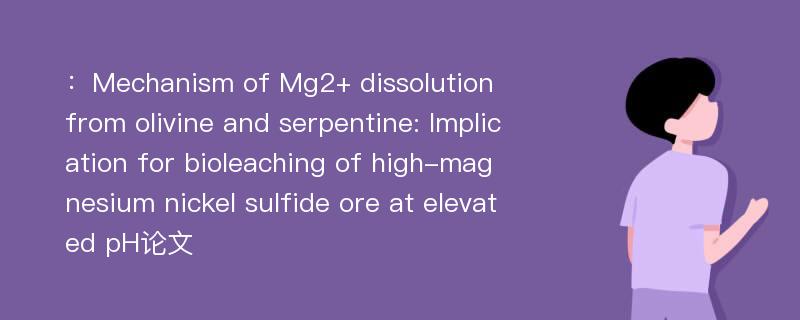
本文主要研究内容
作者(2019)在《Mechanism of Mg2+ dissolution from olivine and serpentine: Implication for bioleaching of high-magnesium nickel sulfide ore at elevated pH》一文中研究指出:To inhibit the dissolution of Mg2+ during the bioleaching process of high-magnesium nickel sulfide ore, the effect of major bioleaching factors on the dissolution of Mg2+ from olivine and serpentine was investigated and kinetics studies were carried out. The results indicated that the dissolution rate-controlling steps are chemical reaction for olivine and internal diffusion for serpentine. The most influential factor on the dissolution of Mg2+ from olivine and serpentine was temperature, followed by p H and particle size. A novel method of bioleaching at elevated pH was used in the bioleaching of Jinchuan ore. The results showed that elevated pH could significantly reduce the dissolution of Mg2+ and acid consumption along with slightly influencing the leaching efficiencies of nickel and cobalt. A model was used to explain the leaching behaviors of high-magnesium nickel sulfide ore in different bioleaching systems. The model suggested that olivine will be depleted eventually, whereas serpentine will remain because of the difference in the rate-controlling steps. Bioleaching at elevated pH is a suitable method for treating high-magnesium nickel sulfide ores.
Abstract
To inhibit the dissolution of Mg2+ during the bioleaching process of high-magnesium nickel sulfide ore, the effect of major bioleaching factors on the dissolution of Mg2+ from olivine and serpentine was investigated and kinetics studies were carried out. The results indicated that the dissolution rate-controlling steps are chemical reaction for olivine and internal diffusion for serpentine. The most influential factor on the dissolution of Mg2+ from olivine and serpentine was temperature, followed by p H and particle size. A novel method of bioleaching at elevated pH was used in the bioleaching of Jinchuan ore. The results showed that elevated pH could significantly reduce the dissolution of Mg2+ and acid consumption along with slightly influencing the leaching efficiencies of nickel and cobalt. A model was used to explain the leaching behaviors of high-magnesium nickel sulfide ore in different bioleaching systems. The model suggested that olivine will be depleted eventually, whereas serpentine will remain because of the difference in the rate-controlling steps. Bioleaching at elevated pH is a suitable method for treating high-magnesium nickel sulfide ores.
论文参考文献
论文详细介绍
论文作者分别是来自International Journal of Minerals Metallurgy and Materials的,发表于刊物International Journal of Minerals Metallurgy and Materials2019年09期论文,是一篇关于,International Journal of Minerals Metallurgy and Materials2019年09期论文的文章。本文可供学术参考使用,各位学者可以免费参考阅读下载,文章观点不代表本站观点,资料来自International Journal of Minerals Metallurgy and Materials2019年09期论文网站,若本站收录的文献无意侵犯了您的著作版权,请联系我们删除。
标签:International Journal of Minerals Metallurgy and Materials2019年09期论文;
